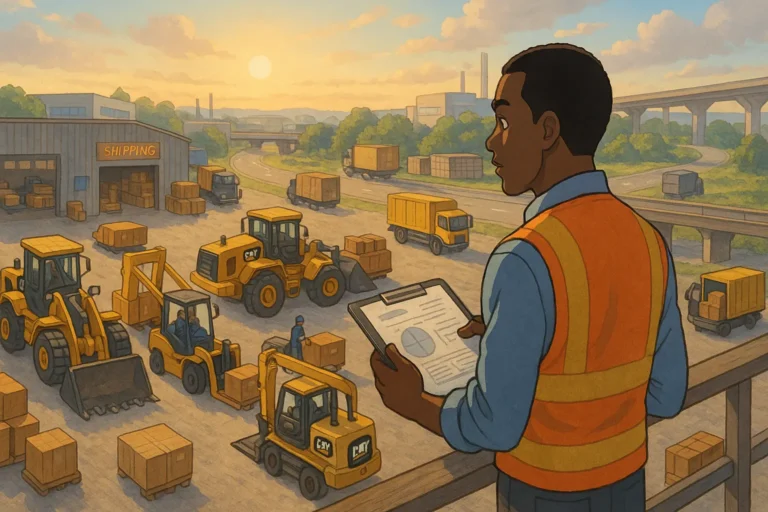
Much has been made about the green warehouse initiative, but is it possible in Africa?
Sustainability is a growing supply chain concept in Africa, but supply chains do not have to wait for others to jump on the trend because they can dive in, especially for a green warehouse. In this article, we will explore all about it.
Your warehouse is integral to your supply chain. It is the first and last point for inventories entering your warehouse, whether before production or before delivery to the customer.
What is a Green Warehouse?
A green warehouse is your traditional warehouse reimagined. It is an eco-friendly storage facility designed to minimize the environmental impact of your warehouse operations.
It incorporates sustainable practices such as energy-efficient lighting, renewable energy sources, waste reduction, and eco-conscious materials.
Taking your warehouse green aims to reduce carbon footprints, conserve resources, and promote environmental responsibility within the supply chain industry.
What are the benefits of Green Warehouse in Africa?
There are several benefits of building a green warehouse in Africa; in this article, we will examine five of them.
Environmental Sustainability
Green warehouses usually mean incorporating renewable energy sources, such as solar panels, which reduce reliance on fossil fuels and their environmental damage.
It will also help your organization lower greenhouse gas emissions.
You will agree that Africa is a beautiful continent. We cannot maintain that beauty by going green across our supply chain, especially in the warehouse and logistics aspect.
Implementing the green warehousing concept will help:
- Reduce Carbon Emissions
- Energy efficiency
- Reduce waste
Cost Savings
Sustainable practices usually lead to more efficient utilization of resources. In the warehouse, that could mean more efficient energy practices using solar, wind, and hydro sources.
These practices often reduce electricity bills, increasing cost savings over time.
By investing in technology and reusable materials across the warehouse, supply chains can also save costs on labour and other warehouse necessities over time.
Employee Wellbeing
A green warehouse will consider your employees’ well-being; to that effect, measures are usually taken to improve their working conditions. Whether it is through automation or eliminating risky activities in the warehouse.
When employees know your warehouse is sustainable and designed to ensure their safety, they are more likely to work longer for you, according to this study by Unily.
Enhanced Reputation
Although sustainability is still a new concept for many businesses and supply chains, especially SME’s, there is a growing number of consumers who are clamouring for it.
Imagine your supply chain stands out due to your green initiatives across all your supply chain facets, including the warehouse.
It will improve your reputation among customers and position your business to partner with international businesses that are very particular about sustainability.
By going green, you have a market advantage.
Supply Chain Efficiency
Going green often leads to operational and overall supply chain optimization. This can help you reduce lead times, collaborate better with suppliers, and deliver the right goods to the consumer at the right time.
In a continent where customer demands are rapidly changing, think how much better your supply chain will be when it is optimize to adapt, reduce waste, and save cost.
Is Green Warehouse Achievable in Africa?
Sustainability is indeed a growing concept in Africa. In fact, the continent just had her first climate summit earlier in 2023, and from the outside, it feels like nothing was achieved. However, it was just its first, and I believe we should give them more leeway.
The good news is that Niger and Tunisia made some promises on the climate front. They have vowed to reduce greenhouse gas emissions by as much as 40%.
So is it possible? The answer is yes, but it will require a lot of commitment from all the major stakeholders, including supply chains, suppliers, and the government.
Best Practices for Green Warehouse in Africa
A green warehouse is not a destination but a journey. It is continuous and never stops. Here are some best practices to get your warehouse green in no time.
Adopting the Reuse, Reduce, & Recycle Principle
One of the main concepts of warehouse sustainability is to reduce the amount of activities and materials used.
Every warehouse has some activities that they can do better. They also have materials they can replace with reusable options, which will help reduce waste and negative environmental impacts.
The main purpose of this principle is to reduce waste by providing alternative materials and processes that can serve you longer and better.
Updated Infrastructure
Infrastructures such as tools and machines used around the warehouse are critical in achieving sustainability.
These tools and machines could include multi-purpose forklifts, highly efficient H-vacs, waste balers and compactors, automated conveyors, solar panels for energy generation, and LED lightening systems.
The type and use of infrastructures in your warehouse can determine how much your sustainability efforts will accomplish.
Proper Waste Management
It is expected that the warehouse will produce waste despite your best efforts to reduce that waste. However, how you dispose of that waste is important to your green warehouse efforts in Africa.
Waste is different, and depending on the type and nature of the warehouse, you may have oil spillage, damaged plastics, unusable nylons and wraps, and so on.
You may read this article on how to optimize warehouse waste for more detailed information on waste disposal processes in the warehouse.
Space Optimization
You must implement space optimization to complete your bid for a greener warehouse.
Optimizing your warehouse space simply means efficiently using up available spaces in your warehouse in an eco-friendly manner.
By implementing space optimization strategies like warehouse slotting, warehouses can reduce their physical footprint, which has several sustainability benefits.
First, it allows for consolidating goods and inventory, reducing the need for larger warehouses and the associated energy consumption for heating, cooling, and lighting.
Second, it promotes better organization and accessibility of goods, minimizing the risk of product damage, spoilage, or obsolescence, which can result in less waste.
Lightening & Ventilation
Ensuring warehouse safety is a part of sustainability, which calls for proper lighting and ventilation.
Shifting to eco-conscious choices such as light-emitting diode (LED) bulbs and automated lighting significantly aids energy efficiency.
LED lights are recognized for their superior efficiency and focused illumination and are increasingly prevalent in industrial and commercial environments.
They have longer lifespans and consume at least 75% less energy.
Enhancing ventilation within a warehouse space is equally vital for heightened efficiency.
Heat could rise and leave the warehouse floor chilly, making workers uncomfortable and demanding continuous heating.
High-speed, low-volume fans tackle this issue by redirecting ascending warm air.
They also facilitate air circulation during summer. These fans contribute to enhanced comfort while curbing energy consumption.
Factors Impacting the efficiency of your Green Warehouse in Africa
Achieving a green warehouse is not a solo effort. The following factors can impact your success.
Suppliers
They play a huge role in your sustainability efforts. However, they can be difficult to manage, especially when goals do not align.
Remember that as much as sustainability is mainstream globally, it is still a fresh concept in Africa.
Government
Government policies can do a lot to drive sustainability efforts. It could also subsidize the high cost of sustainability.
With the right policies, there is a lot of incentive to implement sustainability practices, but without that, you and other supply chains might find it challenging.
Capital
However you slice it, achieving a green warehouse in Africa can be capital intensive, where financing is a major issue for many supply chains, and the lack of capital does little to inspire the push for sustainability.
Many businesses are sticking to traditional methods rather than adopting improved tech solutions because of the same problem.
Many of these supply chains are local, and the traditional method works perfectly.
Customer
Your customers are your trump card. They are the crowd chanting your name at the Colosseum.
While the above factors make it challenging, the customer’s preferences will always win at the end of the day.
To survive in today’s business climate, it is important to always put your customer’s demands first, even when inconvenient.
Management and Employees
Although sustainability is a great feature in the supply chain, especially for major businesses with a lot of operations and capital to spare, the implementation can do a lot to save costs, reduce inefficiencies, and promote a good work culture.
Yet, convincing the top management, especially when the traditional method has been effective and profitable, can be very challenging for a supply chain manager.
If they do not sign up for it, taking your warehouse green will be rather difficult.
FAQs on Green Warehouse in Africa
Q1: Are green warehouses more expensive to construct and maintain?
Green warehouses often result in long-term benefits through decreased energy usage and operational costs despite the slightly higher initial building costs.
These savings often outweigh the original outlay.
Q2: How can renewable energy sources fit into the design of a green warehouse in Africa?
Green warehouses can be powered sustainably by renewable energy sources like solar or wind turbines, which will lessen their dependency on fossil fuels and cut carbon emissions.
Q3: How can I evaluate an African warehouse’s sustainability?
Examine the warehouse’s energy efficiency, waste management procedures, usage of renewable energy, building materials, and adherence to green building guidelines and certifications to determine its sustainability.

Obinabo Tochukwu Tabansi is a supply chain digital writer & ghostwriter helping professionals and business owners across Africa explore various strategies that work and learn from the success and failures of various supply chains across the globe. He also ghostwrites social content for logistics & supply chain businesses








